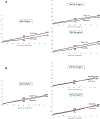Effects of body mass index on kidney transplant outcomes are significantly modified by patient characteristics
- PMID: 32654372
- PMCID: PMC8905683
- DOI: 10.1111/ajt.16196
Effects of body mass index on kidney transplant outcomes are significantly modified by patient characteristics
Abstract
Body mass index (BMI) is a known risk factor associated with kidney transplant outcomes and is incorporated for determining transplant candidate eligibility. However, BMI is a coarse health measure and risks associated with BMI may vary by patient characteristics. We evaluated 296 807 adult (age > 17) solitary kidney transplant recipients from the Scientific Registry of Transplant Recipients (2000-2019). We examined effects of BMI using survival models and tested interactions with recipient characteristics. Overall, BMI demonstrated a "J-Shaped" risk profile with elevated risks for overall graft loss with low BMI and obesity. However, multivariable models indicated interactions between BMI with recipient age, diagnosis, gender, and race/ethnicity. Low BMI was relatively higher risk for older recipients (>60 years), people with type I diabetes, and males and demonstrated no additional risk among younger (18-39) and Hispanic recipients. High BMI was associated with elevated risk for Caucasians and attenuated risk among African Americans and people with type II diabetes. Effects of BMI had variable risks for mortality vs graft loss by recipient characteristics in competing risks models. The association of BMI with posttransplant outcomes is highly variable among kidney transplant recipients. Results are important considerations for personalized care and risk stratification. Findings suggest that transplant contraindications should not be based on absolute BMI thresholds but modified based on patient characteristics.
Keywords: clinical research/practice; diabetes: type 1; epidemiology; ethnicity/race; gender; graft survival; health services and outcomes research; kidney transplantation/nephrology.
© 2020 The American Society of Transplantation and the American Society of Transplant Surgeons.
Conflict of interest statement
DISCLOSURE
The authors of this manuscript have no conflict of interests to disclose as described by the
Figures









References
-
- Strandberg TE, Stenholm S, Strandberg AY, et al. The “obesity paradox,” frailty, disability, and mortality in older men: a prospective, longitudinal cohort study. Am J Epidemiol. 2013;178:1452–1460. - PubMed
-
- Kuehn B. Obesity rates increasing. JAMA. 2018;320:1632. - PubMed
-
- Gore JL, Pham PT, Danovitch GM, et al. Obesity and outcome following renal transplantation. Am J Transplant. 2006;6:357–363. - PubMed
MeSH terms
Grants and funding
LinkOut - more resources
Full Text Sources
Medical

